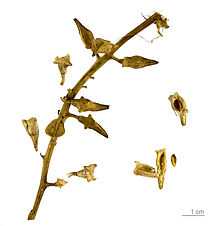Cakile maritima
| Cakile maritima | |
|---|---|
_1.jpg) | |
| Scientific classification | |
| Kingdom: | Plantae |
| (unranked): | Angiosperms |
| (unranked): | Eudicots |
| (unranked): | Rosids |
| Order: | Brassicales |
| Family: | Brassicaceae |
| Genus: | Cakile |
| Species: | C. maritima |
| Binomial name | |
| Cakile maritima Scop. | |

Cakile maritima, the European searocket, is a common plant in the mustard family. It is widespread in Europe, especially on coastlines, and it can now be found in other areas of the world where it has been introduced. It is an inhabitant of the west and east coasts of North America, where it has the potential to become a noxious weed. This is an annual plant which grows in clumps or mounds in the sand on beaches and bluffs. The shiny leaves are fleshy, green and tinted with purple or magenta, and long-lobed. It has white to light purple flowers and sculpted, segmented, corky brown fruits one to three centimeters long. The fruits float and are water-dispersed.
Veterinary significance
The seed oil contains a high level of erucic acid, which can have pathological effects on the cardiac muscle of several animal species. However, Orange-bellied Parrots feed on its seed during their northward migrating journey from Tasmania.
External links
| Wikimedia Commons has media related to Cakile maritima. |